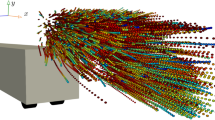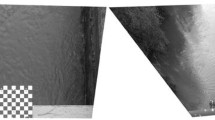Abstract
This paper describes a measurement technique that was successfully applied in a study of bed load transport of large spherical solid particles in a shallow and supercritical flow (Fr = 2.59–3.17) down a steep slope. The experimental condition was characterized by the relatively large solid particle size compared to the flow depth (d p /h = 0.23–0.35), and compared to the tracer diameter (d p /d t ≈ 130). The technique incorporated particle image velocimetry and particle tracking velocimetry (PTV) to simultaneously measure the characteristics of the two phases. In order to detect true solid particles and to distinguish them from each other and the unwanted objects, a particle characterization (PCR) algorithm based on Hough transform was employed. The output from the PCR process was utilized for PTV, as well as to generate the corresponding tracer images for special needs. Validation tests have confirmed the pixel accuracy and high reliability of the combined technique. Experimental results obtained with the developed technique include flow velocities, particle velocities, and concentration. The analysis has shown that the particle concentration profile followed an exponential relationship of the form similar to that of Rouse’s profiles, despite the large d p /h ratio. It also revealed the effect of phase interaction, as a low loading rate of light particles on the order of O(10−3) could yield a noticeable slowdown in the streamwise fluid velocity.





















Similar content being viewed by others
References
Ancey C, Bigillon F, Frey P, Lanier J, Ducret R (2002) Saltating motion of a bead in a rapid water stream. Phys Rev E Stat Nonlin Soft Matter Phys 66(3)
Argialas DP, Mavrantza OD (2004) Comparison of edge detection and hough transform techniques in extraction of geologic features. In: Proceedings of the XXth ISPRS congress of the international society of photogrammetry and remote sensing, Istanbul, Turkey, pp 1682–1750
Armanini A, Fraccarollo L, Larcher M (2008) Liquid-granular channel flow dynamics. Powder Technol 182(2):218–227
Bohm T, Frey P, Ducottet C, Ancey C, Jodeau M, Reboud JL (2006) Two-dimensional motion of a set of particles in a free surface flow with image processing. Exp Fluids 41(1):1–11
Breugem WA, Uijttewaal WSJ (2006) A PIV/PTV experiment on sediment transport in a horizontal open channel flow. In: Proceedings of the international conference on fluvial hydraulics—river flow 2006, Lisbon, pp 789–798
Breugem WA, Uijttewaal WSJ (2007) Sediment transport by coherent structures in a turbulent open channel flow experiment. In: Bernard J, Geurts et al (eds) Particle laden flow. Springer, Netherlands, pp 43–55
Canny J (1986) A computational approach to edge detection. IEEE Trans Pattern Anal Image Process 8(6):679–698
Capart H, Young DL, Zech Y (2002) Voronoï imaging methods for the measurement of granular flows. Exp Fluids 32(1):121–135
Cheng NS (2003) Discussion of “two-phase flow analysis of concentration profiles” by Blair P. Greimann and Forrest M. Holly Jr. J Hydraulic Eng 129:245
Cheng NS (2004) Analysis of velocity lag in sediment-laden open channel flows. J Hydraulic Eng 130(7):657–666
Cheng Y, Pothos S, Diez FJ (2010) Phase discrimination method for simultaneous two-phase separation in time-resolved stereo PIV measurements. Exp Fluids
Dantec (2002) Flow manager software and introduction to PIV instrumentation. In: Software user’s guide. Skovlunde, Denmark
Greimann BP, Muste M, Holly Jr FM (1999) Two-phase formulation of suspended sediment transport. J Hydraulic Res 37(4):479–499
Greimann BP, Holly Jr FM (2001) Two-phase flow analysis of concentration profiles. J Hydraulic Eng 127(9):753–762
Hassan YA, Blanchat TK, Seeley CH Jr, Canaan RE (1992) Simultaneous velocity measurements of both components of a two-phase flow using particle image velocimetry. Int J Multiphase Flow 18:371–395
Herschy RW (2009) Streamflow measurement. Routledge, London; New York
Hough PVC (1962). Method and means for recognizing complex patterns. US Patent 3069654
Ioannou D, Huda W, Laine AF (1999) Circle recognition through a 2D Hough transform and radius histogramming. Image Vis Comput 17:15–26
Kaftori D, Hetsroni G, Banerjee S (1998) The effect of particles on wall turbulence. Int J Multiph Flow 24(3):359–386
Khalitov DA, Longmire EK (2002) Simultaneous two-phase PIV by two-parameter phase discrimination. Exp Fluids 32(2):252–268
Kiger KT, Pan C (2000) PIV technique for the simultaneous measurement of dilute two-phase flows. J Fluids Eng Trans ASME 122(4):811–818
Kiger KT, Pan C (2002) Suspension and turbulence modification effects of solid particulates on a horizontal turbulent channel flow. J Turbul 3:1–21
Kulpa Z (1979) On the properties of discrete circles, rings and disks. Comput Graph Image Process 10:348–365
Larcher M, Fraccarollo L, Armanini A, Capart H (2007) Set of measurement data from flume experiments on steady uniform debris flows. J Hydraulic Res 45(SPEC. ISS.):59–71
Leavers VF (1993) Survey: which Hough transform? Comput Vis Graph Image Process Image Unders 58:250–264
Lelouvetel J, Bigillon F, Doppler D, Vinkovic I, Champagne JY (2009) Experimental investigation of ejections and sweeps involved in particle suspension. Water Resour Res 45(2)
Lim JS (1990) Two-dimensional signal and image processing. Prentice Hall, Englewood Cliffs
McIlhagga W (2011) The Canny edge detector revisited. Int J Comput Vision 91:251–261
Mo ST (2010) Research on anti-blooming driving timing for CCD video camera. Guangdianzi Jiguang/J Optoelectron Laser 21(8):1146–1150
Muste M, Yu K, Fujita I, Ettema R (2005) Two-phase versus mixed-flow perspective on suspended sediment transport in turbulent channel flows. Water Resour Res 41(10):1–22
Muste M, Yu K, Fujita I, Ettema R (2009) Two-phase flow insights into open-channel flows with suspended particles of different densities. Environ Fluid Mech 9(2):161–186
Nadernejad E, Sharifzadeh S, Hassanpour H (2008) Edge detection techniques: evaluations and comparisons. Appl Math Sci 2(31):1507–1520
Nezu I, Azuma R (2004) Turbulence characteristics and interaction between particles and fluid in particle-laden open channel flows. J Hydraulic Eng 130(10):988–1001
Noguchi K, Nezu I (2009) Particle-turbulence interaction and local particle concentration in sediment-laden open-channel flows. J Hydro Environ Res 3(2):54–68
Pellegrino FA, Vanzella W, Torre V (2004) Edge detection revisited. IEEE Trans Syst Man Cybern B Cybern 34(3):1500–1518
Raffel M, Willert CE, Kompenhaus J (1998) Particle image velocimetry: a practical guide. Springer, Berlin
Rouse H (1937) Nomogram for the settling velocity of spheres. In: Division of Geology and Geography, Exhibit D of the report of the commission on sedimentation, 1936–37. National Research Council, Washington, D.C., pp 57–64
Yip KKR, Tam KSP, Leung NKD (1992) Modification of Hough transform for circles and ellipses detection using a 2-dimensional array. Pattern Recogn 25(9):1007–1022
Young CA, Gallagher PT (2008) Multiscale edge detection in the corona. Sol Phys 248:457–469
Yuen HK, Princen J, Illingworth J, Kittler J (1990) Comparative study of Hough transform methods for circle finding. Image Vis Comput 8:71–77
Ziou D, Tabbone S (1998) Edge detection techniques-an overview. Int J Pattern Recogn Image Anal 8:537–559
Acknowledgments
Acknowledgement is made to Assoc. Prof. Yuan-Liang Tang (Chaoyang University of Technology, Taiwan) and Assoc. Prof. John C. Crocker (University of Chicago, USA) for the use of their ideas and solutions on Hough transformation and the construction of particle trajectories (main PTV), respectively.
Author information
Authors and Affiliations
Corresponding author
Rights and permissions
About this article
Cite this article
Tuyen, N.B., Cheng, NS. A single-camera technique for simultaneous measurement of large solid particles transported in rapid shallow channel flows. Exp Fluids 53, 1269–1287 (2012). https://doi.org/10.1007/s00348-012-1358-5
Received:
Revised:
Accepted:
Published:
Issue Date:
DOI: https://doi.org/10.1007/s00348-012-1358-5




